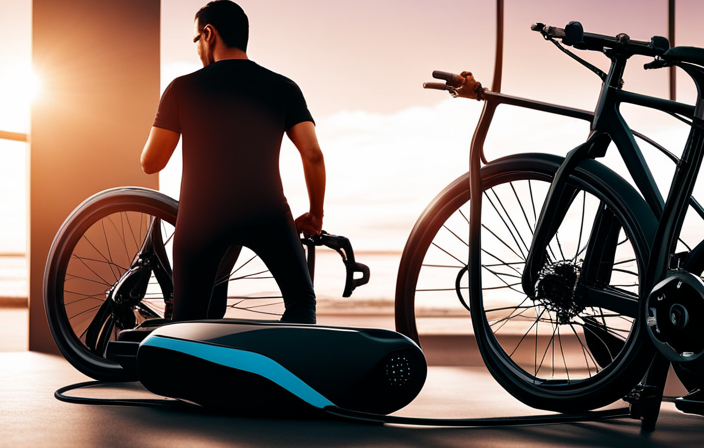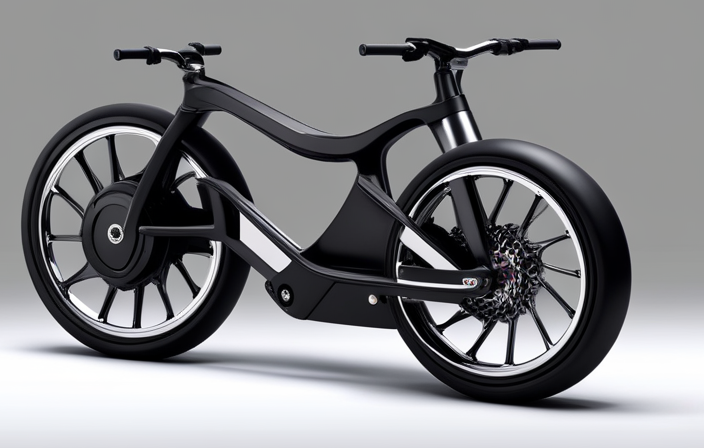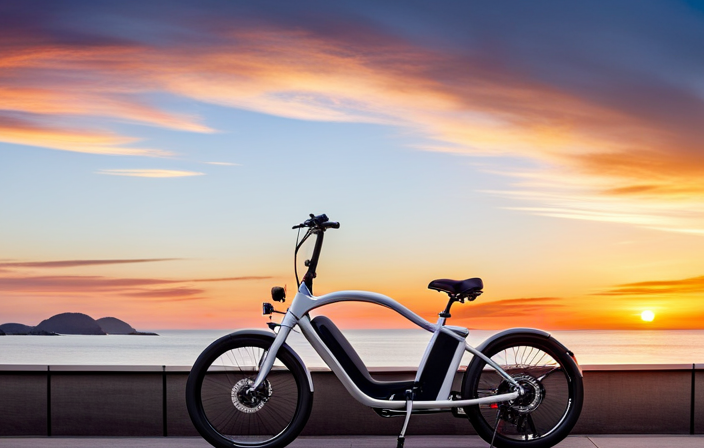Are you eager to hop on your electric bike and hit the road, but wondering how long you’ll have to wait for a full charge? Well, fret no more!
In this article, we’ll delve into the technicalities of battery capacity and type, different charging methods and equipment, and the various factors that can affect charging time.
We’ll also provide average charging times for different e-bikes, along with tips to optimize charging time and portable charging solutions for those on the go.
So, let’s dive in and get your electric bike charged up in no time!
Key Takeaways
- The average charging time for an electric bike is 4-6 hours, but it may take longer for high-capacity batteries.
- It is important to use the manufacturer-provided charger and avoid using a regular phone charger.
- Overcharging, charging to 100%, and letting the battery drain fully can reduce the longevity of the battery.
- Portable charging options like solar chargers and power banks can be used for charging on the go.
Understanding Battery Capacity and Type
It’s important to understand the battery capacity and type of an electric bike when determining how long it takes to charge. Battery maintenance plays a crucial role in the charging process. Regularly checking and maintaining the battery will ensure optimal performance and extend its overall lifespan.
Additionally, it’s essential to consider the impact of temperature on the battery charging time. Extreme temperatures, whether hot or cold, can affect the charging efficiency and duration. High temperatures can lead to faster charging, but it may also reduce the battery’s overall capacity over time. On the other hand, extremely cold temperatures can decrease the charging speed.
Understanding these factors is vital for accurately estimating the charging time of an electric bike.
Moving on to charging methods and equipment, let’s explore the various options available.
Charging Methods and Equipment
Using different methods and equipment, you can quickly recharge an e-bike.
There are a few options for charging your electric bike, depending on your needs and preferences. The most common method is to use the charger that comes with your e-bike. Simply plug it into a standard electrical outlet and connect it to your bike’s battery. This method usually takes a few hours to fully charge the battery.
However, if you’re in a hurry, you can opt for faster charging methods. For example, some e-bikes support fast charging, which can significantly reduce the charging time. Additionally, there are alternative charging methods available such as solar charging or using portable power banks. These methods can be useful for battery maintenance or when you’re on the go.
Factors affecting charging time include battery capacity, charging method, and the type of charger used. These will be discussed in more detail in the next section.
Factors Affecting Charging Time
The factors that affect how quickly an e-bike battery charges include battery capacity, the chosen charging method, and the type of charger used. Battery efficiency plays a crucial role in determining the charging time. A more efficient battery will charge faster compared to a less efficient one.
Additionally, the impact of temperature on charging time is significant. Extreme temperatures, both hot and cold, can slow down the charging process, while moderate temperatures are optimal for quicker charging.
It is important to note that different charging methods and chargers have varying charging speeds. Fast chargers can reduce charging time significantly, while slow chargers may take longer.
Understanding these factors will help you determine the best way to charge your e-bike battery efficiently.
Now, let’s delve into the average charging times for different e-bikes.
Average Charging Times for Different E-bikes
On average, e-bikes typically require around 3 to 5 hours to fully recharge their batteries. However, the actual charging time can vary depending on several factors, including the battery capacity, the charger’s output power, and the current battery level. Additionally, the battery charging speed can be affected by the temperature of the environment. Higher temperatures generally result in faster charging times, while colder temperatures can slow down the charging process. To provide a clearer understanding, consider the following table:
| E-bike Model | Battery Capacity (Ah) | Charging Time (Hours) |
|---|---|---|
| Model A | 10 | 3 |
| Model B | 15 | 4 |
| Model C | 20 | 5 |
Understanding the average charging times for different e-bike models can help you plan your charging schedule more effectively. Optimizing charging time is crucial for maximizing the usage of your e-bike. In the next section, we will explore some tips to help you achieve that.
Tips to Optimize Charging Time
To optimize your charging time for your e-bike, there are several tips you can follow.
-
Use a high-quality charger: Invest in a charger specifically designed for your electric bike, as it will ensure maximum efficiency and quick charging times.
-
Charge at the right time: Take advantage of off-peak hours when electricity rates are lower to charge your e-bike. This will not only save you money but also help maximize the charging speed.
-
Avoid overcharging: Once your e-bike reaches full charge, unplug it promptly. Overcharging can degrade the battery life and slow down future charging times.
By implementing these quick charging techniques and maximizing efficiency, you can reduce the time it takes to charge your electric bike.
Now, let’s move on to the next section about charging etiquette and safety.
Charging Etiquette and Safety
Make sure you follow proper etiquette and safety guidelines when it comes to charging your e-bike. Charging etiquette is important to ensure that everyone has access to charging stations and that the process is efficient. Always be mindful of others and don’t leave your bike plugged in longer than necessary.
Safety precautions are also crucial to prevent accidents and damage to your bike. Avoid charging in extreme weather conditions or using damaged charging equipment. Make sure to use a surge protector and never leave your bike unattended while charging.
It’s important to be responsible and considerate when charging your e-bike to maintain a positive charging experience for everyone.
Speaking of charging, let’s now explore portable charging solutions for on-the-go.
Portable Charging Solutions for On-the-Go
If you find yourself frequently on the go with your electric bike and in need of a quick charge, portable power banks are a great solution. These compact devices can provide a boost of power to your e-bike when you’re away from a traditional charging station.
Additionally, solar charging options are becoming increasingly popular, allowing you to harness the power of the sun to charge your bike’s battery.
Finally, the availability of charging stations and public infrastructure is essential for e-bike users, providing convenient and reliable charging options when you’re out and about.
Portable power banks for e-bikes
Portable power banks for e-bikes can significantly reduce the charging time. These compact and portable devices allow you to charge your electric bike on the go, providing a convenient solution for those who are always on the move. One of the advantages of using portable power banks for e-bikes is that they are compatible with a wide range of electric bike models, making them a versatile option for any rider.
To give you an idea of the different portable power banks available, here is a table showcasing three popular options:
| Power Bank Model | Capacity (mAh) | Charging Time (hours) |
|---|---|---|
| PowerBankX | 10,000 | 4 |
| EnergyCharge | 15,000 | 6 |
| TurboJuice | 20,000 | 8 |
With these portable power banks, you can significantly reduce the time it takes to charge your e-bike, allowing you to spend more time riding and less time waiting. In the next section, we will explore solar charging options for e-bikes.
Solar charging options
Solar charging options for e-bikes provide an eco-friendly and convenient solution for powering your ride. With advancements in technology, solar panels have become more efficient, allowing for quicker and more reliable charging. Here are five alternative charging options to consider:
-
Solar panel efficiency: Look for high-efficiency solar panels that can harness more sunlight and convert it into electricity efficiently.
-
Portable solar chargers: These compact chargers can be easily attached to your e-bike and provide a convenient way to charge your battery while on the go.
-
Solar-powered charging stations: Some cities offer solar-powered charging stations specifically designed for e-bikes, allowing you to charge your bike using renewable energy.
-
Integrated solar panels: Certain e-bike models come with integrated solar panels on their frames, enabling them to charge while you ride.
-
Off-grid charging: If you’re on an adventure or don’t have access to traditional power sources, portable solar panels can be used to charge your e-bike battery.
Transitioning into the subsequent section about charging stations and public infrastructure, you can explore the benefits of these options in terms of accessibility and availability.
Charging stations and public infrastructure
You can easily find charging stations and public infrastructure to power your e-bike. With the increasing popularity of electric bikes, charging infrastructure development has been a priority for many governments. They have implemented various initiatives to support the growth of electric transportation.
As a result, charging stations can now be found in urban areas, residential neighborhoods, and even along popular cycling routes. These stations are equipped with fast-charging capabilities, allowing you to quickly charge your e-bike’s battery. Some charging stations even offer additional amenities like bike racks and seating areas.
With the availability of such public infrastructure, you can conveniently charge your e-bike while enjoying a break or running errands.
Transitioning into the subsequent section about extending battery life, it is important to understand how proper charging techniques can help maximize the longevity of your e-bike’s battery.
Extending Battery Life
To extend your battery life, make sure to properly maintain and regularly charge your electric bike. Battery maintenance is crucial for maximizing the lifespan of your battery.
It is recommended to charge your battery after each ride, even if it is not fully depleted. Avoid overcharging your battery as it can lead to decreased capacity over time.
Additionally, store your bike in a cool and dry place when not in use to prevent battery degradation. Regularly inspect your battery for any signs of damage or wear, and replace it if necessary.
By taking these steps, you can ensure that your battery lasts longer and performs optimally.
Now, let’s move on to some frequently asked questions about e-bike charging time.
FAQs About E-bike Charging Time
Wondering about e-bike charging? Here are some FAQs to help you out.
First, can you overcharge your e-bike battery? No worries, modern e-bike batteries have built-in protection to prevent overcharging.
Next, how long does it take to charge a completely drained battery? On average, it takes about 4-6 hours to fully charge an e-bike battery.
Lastly, can you use a regular phone charger to charge your e-bike? It’s not recommended, as e-bike batteries require a higher voltage and current to charge properly.
Can I overcharge my e-bike battery?
Don’t worry about overcharging your e-bike battery. E-bike batteries are designed with built-in protection circuits that prevent overcharging, so you can safely leave your battery plugged in even after it’s fully charged. However, it’s important to note that constantly keeping your battery at 100% charge can reduce its overall longevity. To ensure the best battery longevity, it is recommended to charge your e-bike battery between 20-80% rather than letting it drain completely or charging it to its maximum capacity.
To help you understand the common charging mistakes and their impact on battery life, here’s a table that highlights some key points:
| Common Charging Mistake | Impact on Battery Life |
|---|---|
| Overcharging | Reduced longevity |
| Charging to 100% | Reduced longevity |
| Letting it drain fully | Reduced longevity |
Now that you know about charging mistakes and their impact on battery life, let’s move on to the next section and explore how long it takes to charge a completely drained battery.
How long does it take to charge a completely drained battery?
You may be curious about the amount of time it takes for a completely drained battery to be fully recharged. When it comes to battery charging speed, it is important to understand that it can vary depending on various factors such as the battery capacity and the charger’s output.
On average, it takes around 4 to 8 hours to charge a completely drained electric bike battery. However, some high-capacity batteries may take up to 10 hours or more. To ensure optimal charging, it is recommended to use the charger provided by the manufacturer, as it is specifically designed for your e-bike’s battery.
Using a regular phone charger may not provide the necessary voltage and current, resulting in a slower charging process. Transitioning into the next section, let’s explore whether using a regular phone charger is a viable option for charging your e-bike battery.
Can I use a regular phone charger to charge my e-bike?
If you try to use a regular phone charger, it may not provide the necessary voltage and current to efficiently charge your e-bike battery. While both your phone and e-bike battery may have a USB port, the charging requirements differ.
E-bike batteries typically require a higher voltage and current to charge effectively. However, there are portable charger options available specifically designed for e-bikes that you can use instead. These chargers are equipped with the appropriate voltage and current output to charge your e-bike battery efficiently.
Additionally, there are alternative charging methods you can consider, such as solar chargers or power banks, which provide a convenient way to charge your e-bike battery on the go.
With these options, you can ensure that your e-bike battery is charged properly and ready for your next ride.
Moving on to the conclusion and final tips, let’s discuss some additional considerations for charging your e-bike battery.
Conclusion and Final Tips
To summarize, it’s important to note that charging an electric bike usually takes a few hours. However, there are ways to optimize the charging process and ensure maximum battery efficiency. Here are a few final tips for charging your e-bike:
-
Use portable charging options: If you’re on the go and don’t have access to a regular power outlet, portable chargers can be a convenient solution. Make sure to choose a charger that is compatible with your e-bike’s battery.
-
Avoid overcharging: Overcharging can lead to decreased battery life and performance. Once your e-bike is fully charged, unplug it from the charger to prevent any potential damage.
-
Charge in a cool environment: High temperatures can negatively affect battery health. It’s recommended to charge your e-bike in a cool, well-ventilated area to ensure optimal charging efficiency.
By following these tips, you can charge your electric bike efficiently and maintain the longevity of its battery. Happy riding!
Frequently Asked Questions
Can I use a regular wall outlet to charge my electric bike?
Yes, you can charge your electric bike using a regular wall outlet. It’s one of the convenient charging options available. The charging time may vary depending on the battery capacity and the charger used.
How often should I charge my electric bike’s battery?
To maintain optimal battery performance, charge your electric bike regularly. Charging frequency depends on usage, but it is generally recommended to charge the battery after each ride or at least once every few days. This helps with battery maintenance and ensures a longer lifespan.
Is it possible to overcharge an electric bike’s battery?
Yes, it is possible to overcharge an electric bike’s battery. Overcharging can lead to serious consequences such as reduced battery life, overheating, and even battery failure. Signs of overcharging include a swollen battery, excessive heat, and a strong smell.
Can I charge my electric bike overnight?
You can safely charge your electric bike overnight. However, it is important to consider the charging time and follow charging safety guidelines to avoid any potential issues.
What is the typical lifespan of an electric bike’s battery?
The typical lifespan of an electric bike’s battery can vary depending on factors such as usage, maintenance, and storage conditions. To extend battery life, follow these electric bike battery maintenance tips for optimal performance and longevity.
Conclusion
So, in conclusion, the charging time for an electric bike can vary depending on various factors such as battery capacity, type, charging methods, and equipment used.
It is important to understand these factors and optimize the charging process to ensure efficient charging times. By investing in portable charging solutions and following tips to extend battery life, you can maximize the performance of your e-bike.
Remember to always refer to the manufacturer’s guidelines for charging instructions and consult the FAQs section for any additional information.
Keep these tips in mind to enjoy a hassle-free e-bike charging experience.









